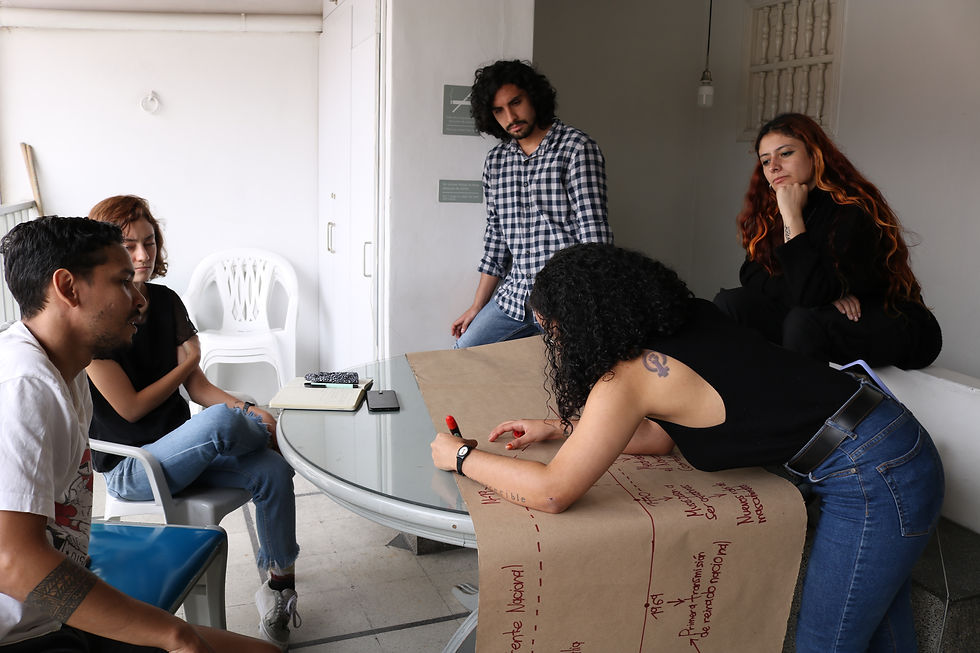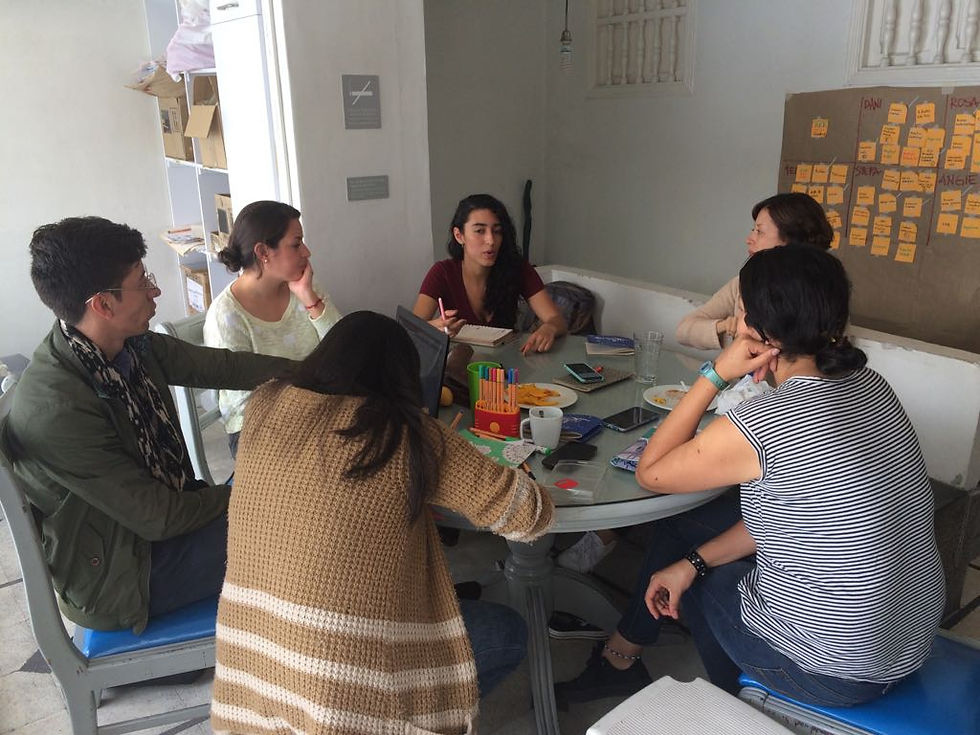Juntarse es resistir
- Comunicaciones C3P
- Oct 25, 2021
- 7 min read
Solidarity can be defined in various ways. In the case of what a city like Medellín has experienced, it can be understood as a social practice that moves people to act in favor of another. In the city, this practice has become part of the life of many neighborhoods that have resisted violence, the absence of the State and lack, that is, solidarity actions have been undertaken at times when a situation is perceived as problematic and unfair in a territory.
30 years ago, in 1991, Medellín was classified as the most violent city in the world; That year 7,273 murders were registered, that is, an approximate of 266 homicides per 100,000 inhabitants, the most difficult period in its history.
The previous one was in this panorama that solidarity, which already existed in many communities, especially in the periphery, was reaffirmed as a scenario of possibility to claim rights, as an alternative to the unjust situations that were being experienced and that ratified the importance of what had already been done since the middle of the 20th century in neighborhoods in the Northeast Zone: overcoming inequalities and addressing the pain of others.
In these neighborhoods, the history of solidarity began in 1948 with the assassination of the liberal political leader Jorge Eliécer Gaitan, which detonated a wave of conflicts throughout Colombia and, above all, in rural areas. This period known as “La Violencia” caused forced displacement of thousands of people who came to the cities seeking refuge and ways to continue with their lives. Those who arrived in these territories realized that the only thing that existed was an informal layout of the space, a product of the division made by the owners of some lots, that is, there was no aqueduct, sewers, health centers or schools and each time More people arrived: in just 10 years it was estimated that 183,813 people already lived in these informal settlements, 15,000 of them in the Popular (Commune 1).
It was thanks to the solidarity that the communes of the northeastern zone developed, which became a paradigmatic model of this city.
One of the first ways in which solidarity is consolidated between these people who came from different municipalities, was through the construction of community works, designed for the common good, from the streets to the aqueduct and sewers, which were given thanks to the organization of the population and the management of resources that the leaders carried out.
A challenge to injustice
Historically within the country that has had a Catholic tradition, there is a paradigmatic manifestation of solidarity that was consolidated with the Liberation Theology movement, which appeared as a challenge to injustice and under the principle of "liberating the poor" and understanding the co-responsibility that exists between men to, precisely, be able to be men.
In Medellín, for example, many community actions were managed under this trend and headed by priests who marked milestones in the city such as Federico Carrasquilla, Guillermo Buitrago or Vicente Mejía, who focused their work with communities with limited resources and that more than as priests they are recognized leaders who promote solidarity in these places. Under the direction of these priests and the union of the people, collective work organizations emerged that sought the well-being of those who inhabited the most vulnerable neighborhoods, such as: Cooperativa Integral Popular, Fundación para la Educación Popular y la Small Industria, Asociación Popular of Industry and Clothing, the Federico Carrasquilla Educational Institution, among others. Likewise, they did not allow State agents, such as the public force, to remove people from their territories: “If they knock one down, we will build two; they knocking down and we stopping ”.

Likewise, in Colombia, many of these acts of solidarity have been seen in collective and community work practices such as the minga, the invitation, lent hand, etc., which are expressions of social dialogue that have even helped to boost economies. that include logics other than monetary.
This impulse to build collectively has to do not only with sharing the same vulnerabilities such as poverty, social and economic exclusion, forced displacement and institutional weakness; but also because it implies reciprocity solidarity, somehow, it established or strengthened a social bond between individuals who are part of a territory. In solidarity acts the possibility that people feel valued, recognized and, ultimately, their potential and their specific features are taken into account as a contribution to building a common world, as suggested Yicel Giraldo Giraldo and Alexander is given Ruiz Silva in the text: La Solidaridad: Another way of being young in the communes of Medellín.
Unity and resistance
The aforementioned also has to do with the fact that in these communities solidarity arises, legitimately, as a form of resistance from which they fight against the silencing, invisibility and exclusion to which they have been subjected in the city. To get together is to resist, to be and to act together; it is to be able to recognize oneself, to identify oneself.
The latter, for example, was very strong in Medellín where, in many neighborhoods, youth groups and other artistic initiatives emerged as an alternative for those who wanted to be recognized without having to get involved in the violent dynamics of their contexts, as happened with Jorge Blandón. who after going through this collective process when he was young and with the learning that he later obtained during his time at the University, founded in 1987 the Nuestra Gente Cultural Corporation, which intended as he says: “to exorcise the violence of the corner, of the street, of the neighborhood ”and that became, with the passage of time, an untouchable space for the armed groups which was able to survive and remain standing thanks to the solidarity of the people and the force of art, in this case , of the theater.
Another example of this is the artist Fredy Serna, who also grew up in the Northeast Zone of Medellín and who realized that his thing was not only to make canvases inspired by the landscape of the hillsides and neighborhoods of the city, but to go out into the streets. to make murals as a call to intervene in the public space.
"When one intervenes in the public space, that has to do with everyone"
Fredy Serna, artist
Giving, receiving and paying back are the three principles of solidarity that, furthermore, presuppose being able to establish horizontal relationships with others; This implies questioning hierarchies, valuing the capabilities of others, and believing in the power of collective action. The latter is key because it starts from reciprocity, voluntary cooperation and commitment and results in the formation of social movements that can, in turn, resist injustices, seek necessary changes for society and build community.
What characterizes social movements today is precisely that “their practices of resistance, of redefining political, public or daily life, are structured around the conditions and cartographies through which current power is conveyed”, as stated in the researcher Israel Rodríguez Giralt. In the case of Colombia, in the last year, many start from claiming empathy to generate solidarity networks around common problems such as the pandemic or social and governmental injustices.

Photo:. La Nueva Banda de la Terraza
Thus, some groups like La Nueva Banda de la Terraza began to do something similar to what Fredy Serna did: use the walls to draw attention to the difficult and inhuman situations that were being experienced, only that instead of a brush, they they used an image projector and social networks to say #IsolatedPeroNoCallados; Others, such as students and teachers from public universities, got together to make “community pots” in neighborhoods where many of its inhabitants, due to quarantine, were starving. The same happened during the 2021 National Strike where many women, mothers and other people made cooking their way of joining the protest: adding strength, ingredients and hopes, as is the case with the group Cooking as Social Action.
All of them have been an example that solidarity, as a form of resistance, is also based on the use of new languages and grammars that create new relationships and different meanings; and this is possible through various artistic expressions, both plastic, scenic and even gastronomic, with which the messages that cry out for social justice can be amplified. The latter was evidenced in the social outbreak in Colombia in 2021 in which art became one of the main ways to convene and raise awareness of the harsh situation that was being experienced: the presentation of an unfair tax reform as a result of the falling GDP in the context of the pandemic, poverty and inequality that did not allow people to respond to the proposed tax hike, system corruption and police violence.
A través de prácticas artivistas como cartelismo, graffittis, performance, presentaciones musicales y comparsas en las marchas, se generaron espacios de encuentro los cuales al permitirle a la gente juntarse en el espacio público y reconocer los elementos comunes que tenía, se posibilitó el formar redes de solidaridad que antes no existían o que estaban resentidas.
Through artistic activist practices such as posters, graffiti, performance, musical presentations and parades in the marches, meeting spaces were generated which by allowing people to gather in the public space and recognize the common elements they had, it was possible to form networks of solidarity that did not exist before or that were resented.
Obstacles to cooperation
Although Medellín is a paradigmatic case of solidarity, it should also be mentioned that in many cases, cooperation is weakened, as is the case in some communes of the city, as expressed in the Local Development Plans. For example, in one of these documents that refers to the Comuna 11 and 14 of Medellín, those where the people with greater purchasing power are found, it states that the "Lack of citizen participation in social processes and dynamics" is very evident.

However, socioeconomic conditions are not the only factors that influence whether or not solidarity networks are consolidated. In Colombia, one of the biggest obstacles to cooperation, to getting involved in the common, has been mistrust. According to the survey carried out in early 2020 by the United States Agency (USAID) and Acdi-Voca's Alliances for Reconciliation program, Colombians only trust their family in high proportions and most believe little or nothing, in the country's social institutions, such as the Government, the media or the Army. And what is even more serious, only 4.8% of those surveyed trust their neighbors, 16.9% trust the majority, 56.6% trust few and 21.8% trust none .
Thus, in a context in which others are perceived negatively, the realization of agreements, the peaceful resolution of conflicts and, in general, collective action are impeded. Therefore, in these moments and in such situations, it is key that social, artistic and cultural organizations can generate meeting spaces to think about the common and where the trust that has been lost in the other can be recovered, as this would allow recognize others as peers who have the right to speak, to participate, and thus build, even from difference, a more just society where work is done to erase inequities and violence.








Comments